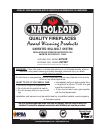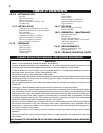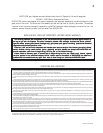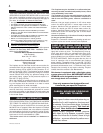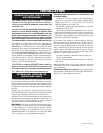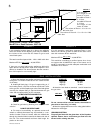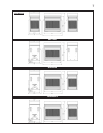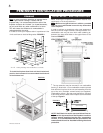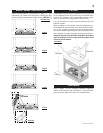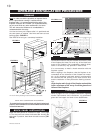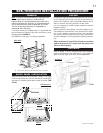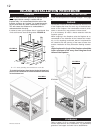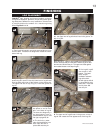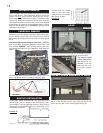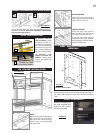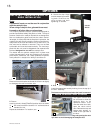
5
W415-0319 / D / 08.03.05
This heater shall not be installed in a confined
space or unusually tight construction unless pro-
visions are provided for adequate combustion and
ventilation air.
In order to avoid the possibility of exposed insu-
lation or vapour barrier coming in contact with
the fireplace body, it is recommended that the
walls of the fireplace enclosure be 'finished', (i.e.
drywall/sheetrock) as would any other outside
wall of the home. This will ensure that clearance
to combustibles is maintained within the cavity.
The National Fuel Gas Code, ANSI Z223.1 defines a con-
fined space as a space whose volume is less than 50
cubic feet per 1,000 Btu per hour (4.8 m
3
per kW) of the
aggregate input rating of all appliances installed in that
space and an unconfined space as a space whose vol-
ume is not less than 50 cubic feet per 1,000 BTU per hour
(4.8 m
3
per kW) of the aggregate input rating of all appli-
ances installed in that space. Rooms communicating di-
rectly with the space in which the appliances are installed,
through openings not furnished with doors are consid-
ered a part of the unconfined space.
The GVF40 is rated at 30,000BTUs per hour for
natural gas and 28,500 BTUs for propane and
therefore requires a minimum unconfined space
of 1,500 and 1,425 cubic feet respectively.
To determine the volume of the room where the heater is
to be installed, multiply the width x the length x the ceiling
height of that room measured in feet. If any adjoining rooms
are connected by grills or openings such as kitchen pass-
throughs, etc., the volume of those rooms may be added to
the total.
Multiply the room volume by 1000 and divide this amount
by 50 to determine the maximum Btu/hr that the space can
support with adequate combustion and ventilation air.
Add the BTU/hr of all fuel burning appliances located within
the space such as gas furnace, gas water heater, etc. Do
not include direct vent gas appliances which draw their
input and output air from and to the outdoors.
WARNING: If the area in which the heater may be oper-
ated is smaller than that defined as an unconfined space
or if the building is of unusually tight construction, provide
adequate combustion and ventilation air by one of the
methods described in the National Fuel Gas Code ANSI
Z223.1, Section 5.3 or the applicable local code.
Unusually tight construction is defined as con-
struction where:
a) Walls and ceilings exposed to the outside atmos-
phere have a continuous water vapour retarder with a
rating of 1 perm (6 x 10
-11
kg per pa-sec-m
2
) or less with
openings gasketed or sealed, and
b) Weather stripping has been added on openable
windows and doors, and
c) Caulking or sealants are applied to areas such as
joints around window and door frames, between sole
plates and floors, between wall-ceiling joints, between
wall panels, at penetrations for plumbing, electrical, and
gas lines, and at other openings.
An unvented room heater is recommended for use as a
secondary heat source rather than as a primary source.
Gas combustion produces water vapour which could oc-
cur at the rate of approximately one ounce of water for
every 1,000 BTU/hr of gas input. During the cold weather
season, indoor humidity levels tend to be low. Conse-
quently, this water vapour can enhance the living space.
However if a problem should occur:
a) ensure sufficient combustion and circulation air
b) use a dehumidifier
c) do not use the unvented room heater as a primary
heat source
Without sufficient fresh air for proper operation, poor fuel
combustion can result. Carbon Monoxide is a result of
poor combustion.
If additional fresh air is required, use one of the meth-
ods described in the National Fuel Gas Code, ANSI Z223.1,
Section 5.3 or the applicable local code.
INSTALLATION
COMBUSTION AND VENTILATION
AIR PROVISIONS
DETERMINING CONFINED OR
UNCONFINED SPACE



